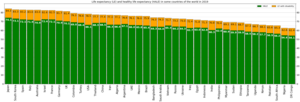This article may require cleanup to meet Wikipedia's quality standards. The specific problem is: Clarification needed at times. (November 2022) |



| 85 ⩾ 82.5 80 77.5 | 75 72.5 70 67.5 | 65 62.5 60 57.5 | 55 ⩽ 53 |

| 70 67.5 | 65 62.5 | 60 57.5 | 55 52.5 | 50 47.5 |

| 22.5 | 20 | 17.5 | 15 | 12.5 |

| 10 | 7.5 | 5 |




Human life expectancy is a statistical measure of the estimate of the average remaining years of life at a given age. The most commonly used measure is life expectancy at birth (LEB, or in demographic notation e0, where ex denotes the average life remaining at age x). This can be defined in two ways. Cohort LEB is the mean length of life of a birth cohort (in this case, all individuals born in a given year) and can be computed only for cohorts born so long ago that all their members have died. Period LEB is the mean length of life of a hypothetical cohort[3][4] assumed to be exposed, from birth through death, to the mortality rates observed at a given year.[5] National LEB figures reported by national agencies and international organizations for human populations are estimates of period LEB.
Human remains from the early Bronze Age indicate an LEB of 24.[6] In 2019, world LEB was 73.3.[7] A combination of high infant mortality and deaths in young adulthood from accidents, epidemics, plagues, wars, and childbirth, before modern medicine was widely available, significantly lowers LEB. For example, a society with a LEB of 40 would have relatively few people dying at exactly 40: most will die before 30 or after 55. In populations with high infant mortality rates, LEB is highly sensitive to the rate of death in the first few years of life. Because of this sensitivity, LEB can be grossly misinterpreted, leading to the belief that a population with a low LEB would have a small proportion of older people.[8] A different measure, such as life expectancy at age 5 (e5), can be used to exclude the effect of infant mortality to provide a simple measure of overall mortality rates other than in early childhood. For instance, in a society with a life expectancy of 30, it may nevertheless be common to have a 40-year remaining timespan at age 5 (but not a 60-year one[dubious – discuss]).
Aggregate population measures—such as the proportion of the population in various age groups—are also used alongside individual-based measures—such as formal life expectancy—when analyzing population structure and dynamics. Pre-modern societies had universally higher mortality rates and lower life expectancies at every age for both males and females.
Life expectancy, longevity, and maximum lifespan are not synonymous. Longevity refers to the relatively long lifespan of some members of a population. Maximum lifespan is the age at death for the longest-lived individual of a species. Mathematically, life expectancy is denoted [a] and is the mean number of years of life remaining at a given age , with a particular mortality.[9] Because life expectancy is an average, a particular person may die many years before or after the expected survival.
Life expectancy is also used in plant or animal ecology,[10] and in life tables (also known as actuarial tables). The concept of life expectancy may also be used in the context of manufactured objects,[11] though the related term[dubious – discuss] shelf life is commonly used for consumer products, and the terms "mean time to breakdown" and "mean time between failures" are used in engineering.
- ^ a b "Life expectancy and Healthy life expectancy, data by country". World Health Organization. 4 December 2020.
- ^ a b c d "World Population Prospects 2024" (XLSX). United Nations Department of Economic and Social Affairs. — see file "Compact (most used: estimates and medium projections)"
- ^ ""Life Expectancy" – What does this actually mean?". Our World in Data. Retrieved 31 August 2020.
- ^ "Period and cohort life expectancy explained: December 2019". Office for National Statistics. UK Government. Retrieved 31 August 2020.
- ^ Shryock HS, Siegel JS (1973). The Methods and Materials of Demography (rev. ed.). Washington, DC: Bureau of the Census, Government Printing Office.
- ^ MacLennan WJ, Sellers WI (January 1999). "Ageing through the ages". Proceedings of the Royal College of Physicians of Edinburgh. 29 (1): 71–5. doi:10.1177/147827159902900114. PMID 11623672.
- ^ "Life expectancy at birth (years) [Indicator]". World Health Organization. 2023. Retrieved 18 December 2023.
- ^ Laden G (1 May 2011). "Falsehood: "If this was the Stone Age, I'd be dead by now"". ScienceBlogs. Archived from the original on 11 November 2012. Retrieved 31 August 2014.
- ^ O'Sullivan A, Sheffrin SM (2003). Economics: Principles in Action. Pearson Prentice Hall. p. 473. ISBN 978-0-13-063085-8.
- ^ Contreras SC, Jurema AL, Claudino ES, Bresciani E, Caneppele TM (1983). "Monowave and polywave light-curing of bulk-fill resin composites: degree of conversion and marginal adaptation following thermomechanical aging". Biomaterial Investigations in Dentistry. 8 (1). Ecological Society of America: 72–78. Bibcode:1983Ecol...64..631M. doi:10.2307/1937181. JSTOR 1937181. PMC 8317947. PMID 34368776.
- ^ Zahavi E, Torbilo V (1996). Fatigue Design: Life Expectancy of Machine Parts. Boca Raton: CRC Press. ISBN 978-0-8493-8970-2.
Cite error: There are <ref group=lower-alpha> tags or {{efn}} templates on this page, but the references will not show without a {{reflist|group=lower-alpha}} template or {{notelist}} template (see the help page).

